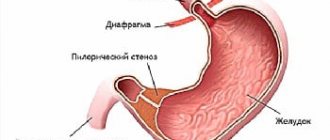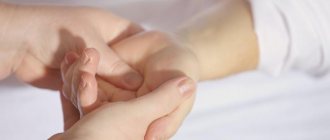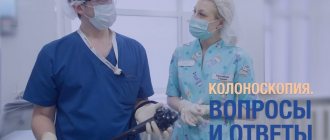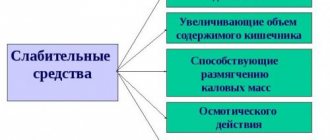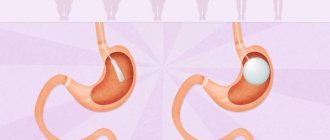Gastric ballooning is an effective endoscopic weight loss method for those who are overweight. The procedure involves inserting a special balloon into the stomach cavity using an endoscope. It fills up space and leaves less room for food. As a result, satiety occurs quickly, the amount of food consumed is reduced, and the patient quickly loses weight.
The intragastric balloon always leads to positive results. The only exceptions are cases when there is a serious hormonal imbalance in the human body. But even this situation is controlled with the help of an endocrinologist and gastroenterologist.
What is a gastric balloon?
The balloon is placed in the stomach when the body mass index is from 30 to 40 kg/m2. It is a silicone “ball” equipped with a special valve.
It is inserted into the stomach through the mouth and then filled with a colored sterile solution. No more than 700 ml of liquid is administered at a time. An increase in its volume may cause forced depressurization of the cylinder.
This measure allows you to timely detect depressurization of the cylinder. When the liquid leaks out, the urine turns the color of the dye. If you skip this process, the deflated balloon can descend into the intestinal lumen and cause complete obstruction.
Silicone cannot be detected by radiology. And to detect a failed balloon, an X-ray contrast mark is installed. To remove the product, open abdominal surgery is required.
How is a gastric balloon installed?
The balloon is installed under general anesthesia and gastroscope observation. The patient is placed on his back or left side. A gastric balloon is inserted into the oral cavity, a syringe is connected to the catheter, and the balloon begins to inflate. The case in which the cylinder is located bursts. It is filled with a certain volume (500 ml), the catheter is removed and the valve is closed. The balloon remains in the lumen of the stomach.
The balloon is removed in the same way, only in reverse order. The procedure is also carried out under light anesthesia, taking no more than 15-20 minutes.
Benefits of ballooning
Inserting a balloon into the stomach is one of the least invasive bariatric procedures, the advantage of which is that it is less traumatic and easy to perform. The duration of the installation procedure is no more than 40 minutes; removal will require a little less time - about half an hour. The patient will be able to return home 3 hours after completion.
The effectiveness of the procedure reaches 80–90%. Over six months of wearing a gastric balloon, weight loss averages 4% of current weight. If the patient can adhere to the principles of rational nutrition, then the results achieved will be stable.
After removal of the balloon - provided the person does not return to previous eating habits - it is possible to increase the current body weight by two to three kilograms.
Since placement of the balloon does not involve surgical manipulation, gastric ballooning completely eliminates the risk of developing cosmetic defects and typical complications - wound infection, bleeding, suture dehiscence, etc.
One of the most important advantages of the technique is reversibility, i.e. the ability to remove the equipment at any time. If necessary, the procedure can be performed again, a month after extraction.
FAQ
B: How much can I lose with this procedure?
O
: You will be able to significantly reduce your weight, by an average of 15-20 kg, but the results depend on how much you follow the program and change your eating habits.
Q: Will I feel the balloon in my stomach?
O
: You may feel discomfort in the first days after the procedure. Then all you will feel is saturation.
Q: Are there any side effects or complications that may occur?
O
: The first three days will be very difficult. Abdominal cramps, nausea and vomiting are normal, expected reactions. It is very important to follow your doctor's advice and drink plenty. You can get medication to relieve discomfort.
Q: How long does the recovery process take after the procedure?
O
: Plan for at least three days of passive rest for recovery. You can continue your daily life depending on how quickly your body gets used to the balloon.
Q: How do weight loss results compare to other nutrition programs?
O
: You are expected to lose more weight with the BIB program. Because the bladder provides a feeling of fullness, you will be able to better control your food intake and make healthy choices.
Q: Does the cylinder restrict any activity?
O
: Don't tire yourself out during the first week after the procedure. Once your body has adjusted to the balloon, you can resume your normal activities. We recommend starting regular training, this will help you achieve success.
Q: What happens if the cylinder starts to leak?
O
: This phenomenon is recognized by the greenish tint of urine. Violation of the integrity of the cylinder wall is rare, but the situation can be serious. If you notice a change in the color of your urine, contact your doctor immediately. If the balloon loses its seal, it is most often removed naturally, but sometimes it must be removed by a doctor.
B: Can I drink alcohol?
O
: Alcohol can be consumed in moderation.
B: Can I eat whatever I want? Are there any food restrictions?
O
: You won't want to eat as much as you did before. In addition, if you eat fatty foods or sweets, your health will worsen. With a balloon in your stomach, overeating can be dangerous and cause serious health problems.
Q: How is the balloon removed?
O
: The balloon is removed in the same way as it was installed - through the mouth. The 20-minute procedure is performed under intravenous or general anesthesia.
The balloon installation procedure is performed by Dr. Rein Adamson , one of Estonia's leading bariatric surgeons.
Watch the video about Victoria, who had mini gastric bypass surgery with Dr. Rain Adamson and lost 42 kg in 12 months!
Execution technique
Balloon gastric bypass surgery is performed after a person has undergone a full medical examination. It includes a consultation with a gastroenterologist and nutritionist. In addition, the patient is prescribed various tests, in particular, examination of the motor and enzymatic functions of the stomach, as well as the condition of its mucosa.
The procedure for installing a gastric balloon is quite simple: the product is placed in the stomach and filled with colored saline solution
If there are no contraindications, the person is given a date for hospitalization. The duration of hospital stay does not exceed several hours, and installation of the balloon takes approximately thirty to forty minutes.
At its core, the procedure resembles fibroesogastroduodenoscopy and involves obtaining local anesthesia. But some clinics practice giving general short-term anesthesia, which completely eliminates all unpleasant sensations.
Manipulations are carried out in the endoscopy room. The patient may undergo either intravenous sedation or local anesthesia.
- The person lies on his left side. After which a tube with a collapsed balloon is placed into the stomach cavity. The entire procedure is carried out under the control of a fiber gastroscope - a specialist observes all manipulations on the monitor screen.
- After the balloon is placed in the stomach, it is filled with tinted saline solution in a volume of 500–700 ml. Methylene blue is used as a dye, and in the event of a rupture of the membrane, a person’s urine will receive a rich blue color - it is impossible to miss it.
- After filling the balloon, the silicone tube is disconnected.
At this point the procedure is considered complete. When filled, the balloon occupies approximately 2/3 of the stomach volume, which promotes faster saturation. That is why ballooning is one of the most common methods for losing weight. Thanks to this, a person begins to eat much less, which leads to a decrease in body weight.
The duration of wearing the balloon is 6 months, then it must be removed. This period is determined by the capabilities of silicone, since the material is not able to withstand constant exposure to hydrochloric acid.
Removing the cylinder proceeds as follows:
- under visual control of a gasteroscope, a wall rupture is performed;
- the liquid filling it is removed;
- the product itself is removed.
Cylinder installation method
A soft silicone balloon is inserted into the stomach using an endoscope and filled with sterile liquid. The inflated balloon is too large to move further into the small intestine, so it floats freely in the stomach. The balloon fills part of the stomach volume, promoting a feeling of fullness.
This method is a non-surgical and non-drug treatment that causes minimal complications. The balloon can be used as a stand-alone weight loss measure or as a preliminary procedure before surgery to reduce the risk of complications.
In cases of extreme obesity, bariatric surgery is technically impossible to perform without first losing weight. To achieve the best results, the balloon can be installed several times in a row after a certain period of time (2 months).
The BioEnterics® Intragastric Balloon (BIB®) program will help you safely and effectively change your appearance and lifestyle to improve your quality of life and health.
Recommendations after the procedure
As a result of the feeling of constant filling of the stomach, a person may experience nausea and even pain in the epigastric region. Due to incomplete filling of the balloon, a constant feeling of hunger may occur. In any case, if such symptoms appear, it is necessary to consult with the specialist who performed the balloon bypass procedure.
The gastric balloon looks like a dense silicone ball
The food restriction rule begins to apply immediately after the balloon is installed. During the first 24 hours, only liquid meals are allowed. The introduction of solid foods into the diet should be done independently in accordance with the schedule drawn up by the attending physician.
It is strictly forbidden to exceed a single volume of food and liquid. Products that increase acidity and cause gas formation should be completely excluded.
During the entire period of wearing a gastric balloon, it is necessary to take medications that reduce the acidity of gastric juice. The medications are selected by the attending doctor. Most often, medications containing omeprozole are prescribed.
Let's get started: what you can expect
Preparation for the procedure
Important to remember:
- Arrange to have someone take care of you at home when you return from the hospital.
- 12 hours before the procedure, you should not consume solid food or liquids.
- Stock up on post-procedure foods and drinks as instructed by your nutritionist.
- Organize for yourself at least three days of passive rest after the procedure.
Day of installation of the cylinder
On the day of your procedure, our team will prepare you for the endoscopic balloon placement procedure, which typically lasts about 20-30 minutes.
The procedure is performed under intravenous (6-month balloon) or general (12-month balloon) anesthesia under the supervision of an anesthesiologist. Before the procedure, the doctor checks the stomach using an endoscope. The empty balloon is inserted into your stomach through your mouth. Once the balloon is in place and filled with sterile solution, you will remain in the clinic until the next morning, meaning you will spend one night in the hospital.
Getting used to BIB
You may feel some discomfort for the first couple of days as your stomach needs to get used to the balloon. As your body adjusts, you may experience nausea, bloating, diarrhea, cramping, and vomiting. These symptoms are quite normal and expected. Your doctor will give you strict instructions about drinking water during this period. In the first couple of days, it is very important to drink enough water and avoid eating solid foods.
For the first three days you should be on a liquid diet, which may include the following:
- juices
- milk
- liquid soups or broths
- jelly
Avoid:
- coffee
- carbonated drinks
- fatty foods
- chocolate
- ice cream
Important to remember:
- Do not engage in vigorous physical activity for the first 24 hours.
- Drink cold drinks in small portions, start with a teaspoon and increase the portion as you feel. If you drink large amounts of liquid, you may feel nauseous or vomit.
- A doctor will be on duty for the first 24 hours after the procedure to immediately deal with any reactions or problems.
Transition to solid foods
After a few days of a liquid diet, you are ready to transition to solid foods. But first you will be given semi-solid food. How quickly you transition to solid foods depends on your progress and how your body tolerates liquids. It is important to maintain a calm pace of transition to solid food; do not rush the adaptation process.
During this period, your nutritionist may advise you to:
- porridge
- thick soups
- fruit purees
Possible complications
Complications associated with the installation of a gastric balloon are very rare. According to statistics, problems occur in only 3% of all operated patients. The most common among all those encountered is intolerance to the balloon.
This condition is accompanied by the following symptoms:
- persistent stomach pain;
- severe heartburn;
- nausea and vomiting.
If there is no effect after taking antispasmodics and antiemetics, provided that pathological symptoms persist, early removal of the balloon is recommended.
Pumping methylene blue-stained saline into a balloon
Due to the prolonged presence of the product in the gastric cavity, approximately 1% of all patients are diagnosed with the formation of ulcerations and erosions on the surface of the mucous membrane. In order to prevent the development of such a complication, patients who have undergone balloon gastric bypass surgery are required to take daily Omeprazole to reduce the acidity of gastric juice.
Spontaneous rupture of the silicone shell or deflation of the balloon occurs in approximately 2% of all cases. The problem makes itself known by the following symptoms: the development of discomfort in the epigastric region, increased appetite, and an increase in the portion taken by the stomach.
An additional sign of rupture is the coloring of a person’s urine blue or green, which becomes possible as a result of methylene blue spilling outside the product.
To confirm suspicions, a person may be prescribed an FGDS procedure or an X-ray of the stomach. In rare cases, the passage of a depressurized balloon into the intestinal lumen is diagnosed, which becomes the cause of its obstruction. A person with this pathology requires emergency surgery.
One of the complications of bypass surgery is the lack of weight loss effect. Sometimes a person does not lose weight at all. The situation develops if the patient refuses to follow a low-calorie diet and does not give the body any physical activity.
Complications and problems
Before the procedure, the specialist warns about possible complications associated with endoscopy and sedation (medicated sleep). Complications may include intestinal blockage due to the balloon, nausea and vomiting, and general stomach discomfort after manipulation. Acid reflux and pain when lying on your back are sometimes observed.
This is the body's reaction to a foreign body. As a rule, such symptoms disappear within a few days after installation. To minimize discomfort, the doctor prescribes medications that reduce secretion levels and recommends following a strict diet for 2-3 days.
In addition, the patient should be warned that after the balloon is removed after 4-6 months, he will be left alone with his stomach. Failure to follow the diet can lead to new weight gain. Therefore, during the period while the balloon is inside the stomach, the patient must get used to limited nutrition.
Indications for gastric ballooning
Balloon gastric bypass is practiced as a method of independent treatment of obesity in patients with a body mass index (BMI) in the range of 30–40 kg/m2, who have not received the expected result after conservative treatment, but do not yet need surgical intervention.
Abdominal obesity
Potential candidates for gastric balloon placement are patients whose BMI exceeds 40. They need weight correction, but the procedure cannot be performed due to the high risk of side effects. In this case, the use of an intragastric balloon is considered as preparation for the upcoming gastro-restructive operation.
Sometimes preliminary weight loss using ballooning is prescribed to obese patients who are about to undergo surgery for other pathologies. For example, removal of a hernia or, if necessary, joint replacement.
Another category of patients who may be recommended to have an intragastric balloon installed are people who are hyperobese and suffer from severe concomitant cardiovascular pathologies.
As a rule, for any surgical intervention they need significant weight loss
Intragastric balloon - reviews
The balloon was installed in October 2012. Today is May 2013. To date I have lost 25 kg. Indeed, if you do not continue your diet, there will be no effect. If you normalize it and try not to eat anything unnecessary (especially high-calorie foods), then there is an effect. Having a balloon is more psychological for me. Although if you overdo it in food, heaviness in the stomach clearly reminds you of it. The trouble is that there are a LOT of temptations around us; all these pies, hamburgers, sprites, etc. are very “tasty” and very affordable, that’s why we eat them. I personally just streamlined and simplified my diet. In the morning, breakfast has been the usual for me for many years (tea and a sandwich), lunch in the catering canteen first, second and “compote” (I had to give up compote due to a side effect, more about it below). Dinner at home - second course and tea. Due to the fact that I go to bed late (usually about 12 o’clock), at about 9 I allow myself another tea with a minimum of snacks (cheese or sausage without bread). In between, no snacks, drinking tea with cookies or the like, excluded all kinds of fast food and carbonated drinks. I only allow tea or coffee with sugar but no sweets or anything else. Yes, perhaps if I had eaten the same way, I would have lost the same weight before and not gained weight. But alas, it didn’t work out. The balloon gave impetus to the process of losing weight. I SAW A REAL EFFECT. When you see your weight decrease on the scale every morning, you get excited. Now about my condition. The first day at home (after anesthesia and other things) when I was leaving. It was very unpleasant; I really don’t know whether it’s from the balloon or the anesthesia, I can’t judge. I suffered from heartburn for two days, but after starting to take motilium and omeprazole (as directed by the doctor), the heartburn went away. I took the drugs for a couple of months, then the heartburn stopped, then I coped with them a couple of times. The first months the effect is huge minus 2-3 kg per month, then a decrease of 200 g per day is an average phenomenon. New Year's holidays and a vacation trip (accordingly, a change in the usual rhythm of eating) passed without losing weight, but also without gaining it. As of today -200 gr. normal result. There are breakdowns, for example, I ate a lot of salted fish and drank a lot of water in the evening as a result of +400g. After such days, I tighten my diet a little, cutting it down a little. The weight loss effect is returning. Sometimes I do fasting days like Tea with biscuits 3 times a day and that’s it. The effect can be up to 1 kg per day. Another side effect has appeared - when drinking juices, kampots, fruits, sometimes an unpleasant belching occurs, as if something is fermenting in the stomach. It is inconvenient in front of others and when measured on a breathalyzer it gives about.3 ppm, which can cause trouble when communicating with the traffic police. True, I have not yet communicated with the traffic police in this state. I try to unload at the same time and not consume the above products again (except in the evening at home). That's probably all I can say from my own experience. I’ll probably wear the balloon until September (either the doctors are on vacation or the men are on vacation, so I’ll wait). Perhaps the worst thing will begin after its removal. If you return to improper and irrational nutrition later, the weight will creep up again. I want to hope that I can maintain my eating style, then we’ll see. Apart from the above-mentioned inconveniences, I didn’t experience any more, I lived as I lived, home, work, rest. I didn’t do any special physical activity (although I did AT ALL), sometimes I used an exercise bike, housework, and helping raise my granddaughter. That's probably all. I repeat once again - when every day you see the EFFECT of the balloon and your regime in the form of the kilograms going away, when you buy new jeans (because it’s simply embarrassing and uncomfortable to wear the old ones), you get excited - and maybe you can still lose them.
Absolute contraindications to the procedure
The technique has a number of contraindications, in the presence of which placement of the balloon is impossible. These are recognized as:
- childhood - the patient cannot be less than 14 years old;
- period of pregnancy and breastfeeding;
- recently performed surgical interventions on the abdominal organs, including gynecological ones;
- the presence of inflammatory processes and/or probable sources of bleeding in the gastrointestinal tract;
- diagnosing a diaphragmatic hernia, narrowing or other anomalies in the structure of the pharynx, esophagus, or stomach;
- the need to regularly take certain medications, for example, those that increase the acidity of gastric juice;
- presence of mental illness, alcoholism, drug addiction, etc.
A gastric balloon is a good solution to the problem of excess weight, but the purpose of the technique must be confirmed by its necessity. This is the lack of effect from conservative therapy. The procedure is possible only after a comprehensive examination of the patient.
Is the BIB program right for you?
The BIB program is suitable for people who meet the following conditions:
- age not younger than 18 years
- obesity problem, BMI from 30
- willingness to comply with a serious medical program
In addition, there are a number of medical reasons for which the BIB program is contraindicated. You will not be able to complete the program if you have one of the following conditions:
- previous gastroenterological surgery, obstruction, peritonitis with adhesions, or large diaphragmatic hernia
- serious kidney, liver, or lung disease
- chronic, long-term treatment with steroids
- unwillingness to follow the nutritional principles necessary to achieve success in treatment
- drug or alcohol addiction within the last 12 months
- pregnancy
As with all medical procedures, there is a potential risk of unexpected, unknown or adverse reactions to medications and procedures. Discuss any questions and expectations you have about the BIB program with your doctor, and weigh the potential benefits and risks.
Reviews about the gastric ballooning procedure
Quite a significant weight loss without any effort on the part of the losing weight patient after the balloon removal procedure may be accompanied by a re-gain of extra pounds. According to statistics, only a third of all patients try to adhere to all the recommendations of the treating doctor and are ready to completely change their usual life.
Maintaining the results of weight loss is possible only if you follow the principles of dietary nutrition and physical activity
It is for this reason that balloon gastric bypass has quite a lot of negative reviews. First of all, it is worth listening to the responses to the technique from those patients who, even after removing the balloon, were able to maintain dietary restrictions and continue to lead a physically active lifestyle.
Sergey: We installed a gastric balloon in preparation for gastric banding. The weight was very high and I needed to lose weight. I got the desired weight result.
Ksenia: I decided to resort to gastric ballooning when my weight started to go through the roof. I didn’t get particularly impressive results, but I was still able to lose weight.
Olga: I placed a balloon in the stomach on the recommendation of my doctor. The thing is unpleasant, but quite effective. By following a diet and giving myself a little physical activity, I was able to lose weight to an acceptable level.


